Ted Joans
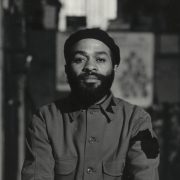

Search for art, find what you are looking for in the museum and much more.
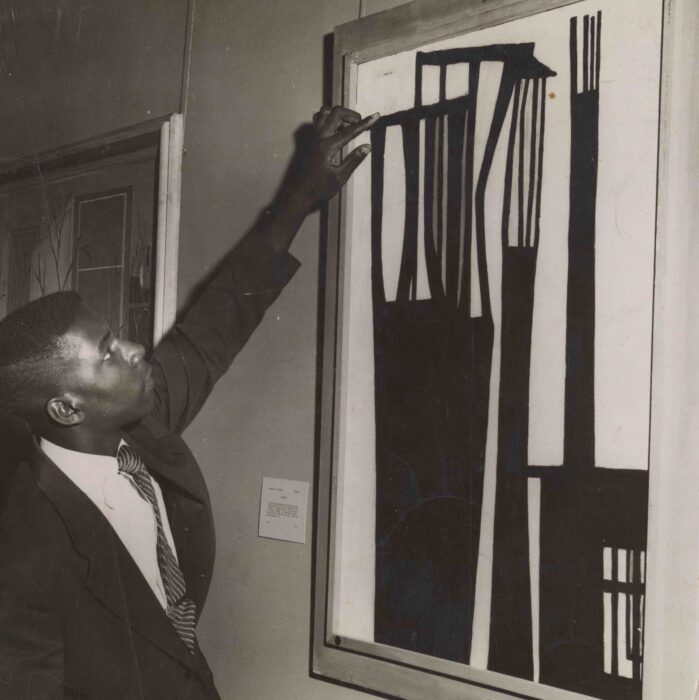
Explore the life and work of Virginia artist and educator Benjamin Wigfall and learn how his own work as an artist and art educator reflected and shaped the communities where he lived.
Benjamin Wigfall left an indelible mark across several communities in Virginia and New York. This story highlights Wigfall’s paintings, prints, assemblages alongside items from his archive charting his career from his work in the late 1940s through his founding and running of Communications Village in the 1970s and early 1980s.
Wigfall’s deep engagement with the people in the neighborhoods and institutions where he lived, studied, taught, and worked increasingly became his art. Read more about these communities, Wigfall’s connection to VMFA and his artistic practice to recognize the enduring legacy of this artist.
This Collection Story was created in conjunction with the exhibition Benjamin Wigfall and Communications Village (on view at VMFA June 17, 2023 – September 10, 2023). More information about the exhibition can be found on the exhibition page.
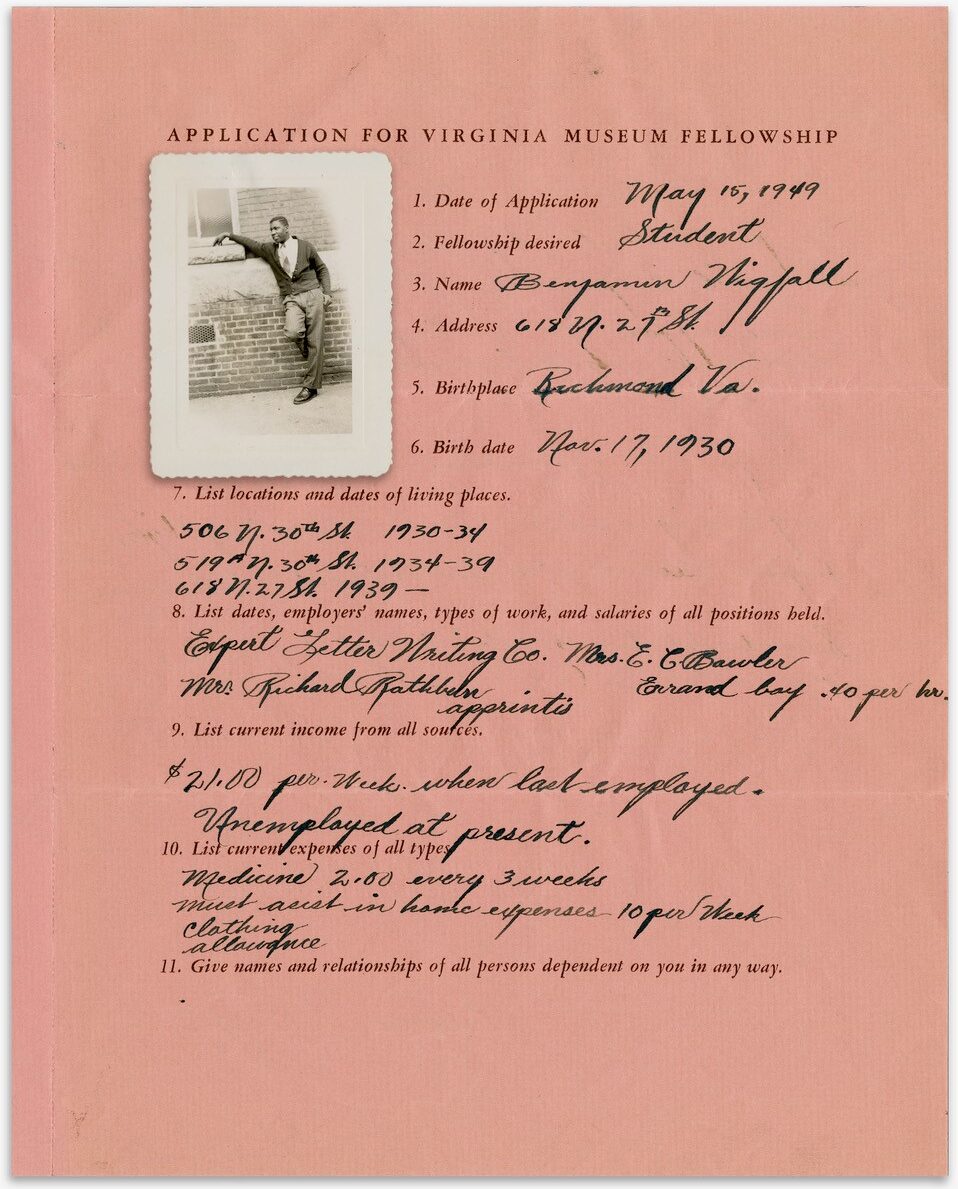 Benjamin Wigfall’s Virginia Museum of Fine Arts Fellowship application with photograph, May 15, 1949. Director’s Correspondence (RG-01), Margaret R. and Robert M. Freeman Library, VMFA Archives, Richmond, Virginia, RG01.01.1.33863.007
Benjamin Wigfall’s Virginia Museum of Fine Arts Fellowship application with photograph, May 15, 1949. Director’s Correspondence (RG-01), Margaret R. and Robert M. Freeman Library, VMFA Archives, Richmond, Virginia, RG01.01.1.33863.007 In the nearly ninety years since VMFA was founded, no other artist’s story weaves so consistently through the warp and weft of both the museum’s acquisition program and its educational mission than that of Benjamin Wigfall. Wigfall’s artistic skills were evident from a young age, but regular art classes were not offered at Armstrong High School, where he was a student. After Wigfall repeatedly asked the principal to hire an art teacher, Stafford Evans appeared in the spring semester of his senior year. The new teacher, Wigfall recalled, changed his life. Evans brought him to the Virginia Museum of Fine Arts for the first time, to attend segregated art classes. There he met Mary Godfrey, assistant state supervisor for art education, who encouraged him to apply for a VMFA fellowship to attend Hampton Institute.
Wigfall submitted this ink drawing of a house on 30th Street in Church Hill, along with his successful 1949 VMFA fellowship application. Wigfall applied for two more VMFA fellowships. Explore Wigfall’s fellowship applications below!
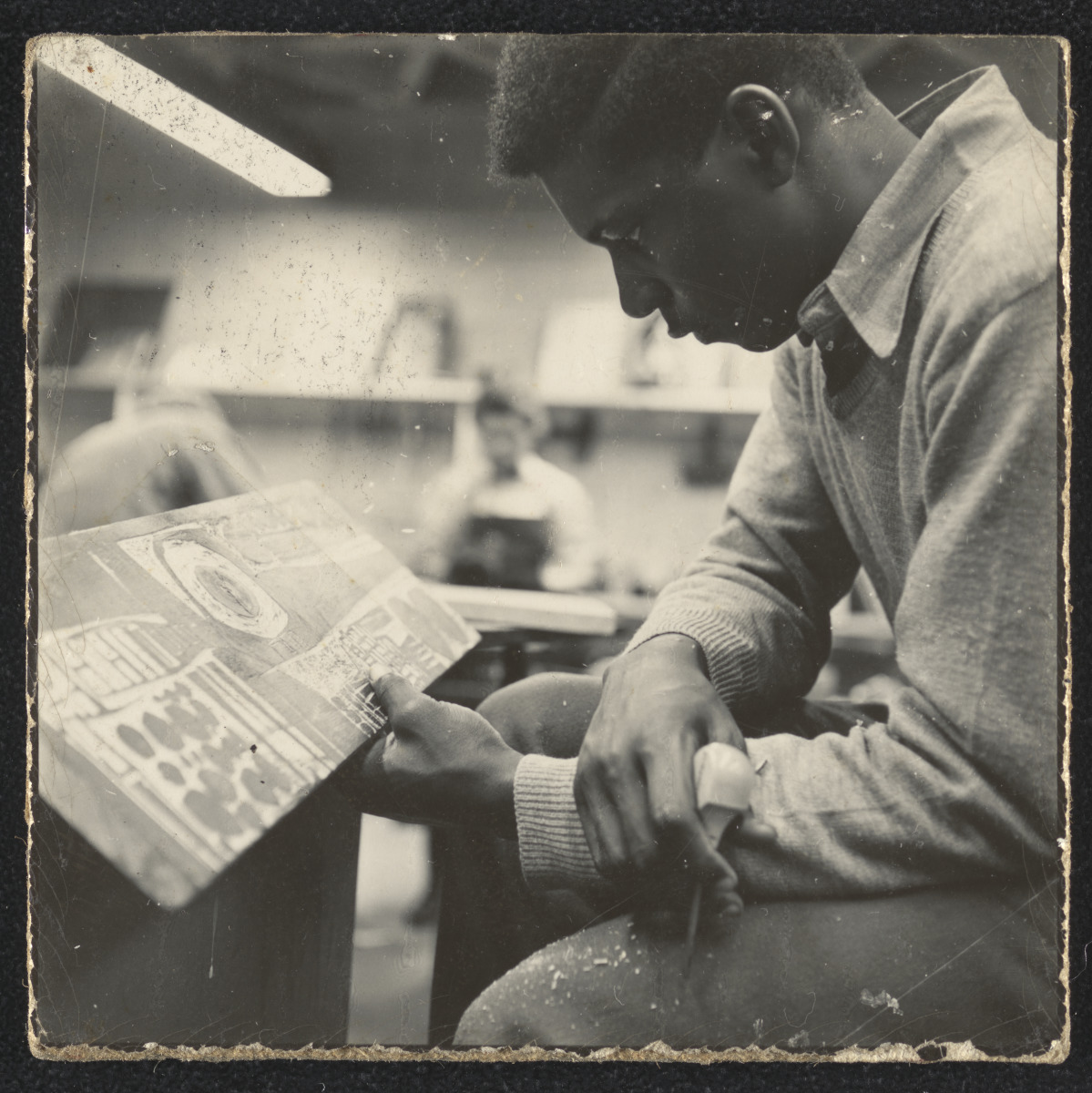 Wigfall Holding a Woodblock in the Yale University Studio, ca. 1954, gelatin silver print, 2 1/2 x 2 1/2 in., Benjamin L. Wigfall Artist Archives (VA-12). Gift of Michael Gino Wigfall and Gia Oke-Bello, Margaret R. and Robert M. Freeman Library, VMFA Archives, VA12.01.2.003
Wigfall Holding a Woodblock in the Yale University Studio, ca. 1954, gelatin silver print, 2 1/2 x 2 1/2 in., Benjamin L. Wigfall Artist Archives (VA-12). Gift of Michael Gino Wigfall and Gia Oke-Bello, Margaret R. and Robert M. Freeman Library, VMFA Archives, VA12.01.2.003 The Wigfall family generously donated the artist’s archive to VMFA’s Margaret R. and Robert M. Freeman Library to accompany the museum’s recent acquisition of additional works of art in 2022. A National Endowment for the Humanities grant, The Preservation Training Initiative, funded an archives graduate intern position to catalogue and rehouse the entire archive, and digitize over 200 items from the archive. The digitized archival items can be found in the VMFA Library’s digital collections, hosted by the Library of Virginia.
Portions of the archive and 37 paintings, prints and assemblages, along with other works, are featured in the special exhibition, Benjamin Wigfall and Communications Village, which will be on view at VMFA from June 17 to September 10, 2023. The exhibition is the first retrospective of Wigfall’s art from the beginning of his career in Virginia to his founding of Communications Village. In addition to works of art, the story of Wigfall’s legacy and artistic development will be told through letters, notes, photographs, sketchbooks, printing plates and ephemera generously donated to the museum by the Benjamin Wigfall Estate.
Explore two of Wigfall’s sketchbooks from the archive.
Benjamin Wigfall was raised in a close-knit African American community in the Church Hill neighborhood of Richmond’s East End in the 1930s and 1940s. His father, James Andrew, worked for the railroad, and his mother, Willie Cogena, worked in the city’s tobacco warehouses before opening a beauty salon located behind their house on 27th Street. He had two older sisters, Josie and Florence. Read more about key moments in Wigfall’s life in the timeline below.
Abstraction served as Wigfall’s primary artistic language, and printmaking increasingly became his main artistic medium. Woodblocks and etching plates accompany their corresponding prints at several points in the exhibition. Along with other archival material, they help demonstrate how the multistep process of making prints allows a singular, artistic vision to become a shared experience of community expression.
The two very different images on the opposing sides of this woodblock demonstrate Wigfall’s continued explorations of both figurative and abstract art through the early 1950s. He made Composition (at right below)in 1954 while studying at Yale; however, it is not clear when he carved or printed Jumprope (at left below). His sketchbooks, which can be previewed in the Acquisition of the Benjamin Wigfall section of this story, from the same era, show him moving back and forth seamlessly between recognizable drawings of people or landscapes on one page and abstracted compositions of lines and shapes on the next.
(Left) Jumprope, ca. 1952–54, Benjamin Wigfall (American, 1930-2017), woodcut on mulberry paper, 24 5/8 × 17 in. Virginia Museum of Fine Arts, Arthur and Margaret Glasgow Endowment, 2022.199. (Right) Composition, 1954, Benjamin Wigfall (American, 1930-2017), woodcut on mulberry paper, 25 3/8 × 17 1/8 in. Virginia Museum of Fine Arts, Arthur and Margaret Glasgow Endowment, 2022.198. Jumprope (recto); Composition (verso), ca. 1952-54, Wood. Benjamin L. Wigfall Artist Archives (VA-12), Gift of Michael Gino Wigfall and Gia Oke-Bello, Margaret R. and Robert M. Freeman Library, VMFA Archives, VA12.08.1.003
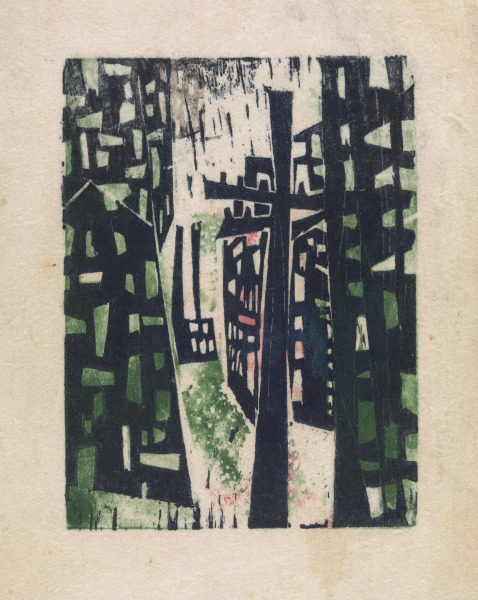 Untitled, ca. 1950-1955, Benjamin Wigfall (American, 1930-2017), woodcut printed in black, green and red inks on textile, 11 7/8 × 9 3/8 in. Virginia Museum of Fine Arts, Arthur and Margaret Glasgow Endowment, 2022.197
Untitled, ca. 1950-1955, Benjamin Wigfall (American, 1930-2017), woodcut printed in black, green and red inks on textile, 11 7/8 × 9 3/8 in. Virginia Museum of Fine Arts, Arthur and Margaret Glasgow Endowment, 2022.197 This relief print is undated but probably originates from Wigfall’s earliest experiments with abstraction and printmaking as a student. Although Wigfall recalls embracing printmaking more fully as a graduate student at Yale University in 1954, he likely made his first prints much earlier while he was studying as an undergraduate at Hampton Institute.
His teacher and mentor there, Leo Katz, was also a member and co-director of Stanley William Hayter’s print studio, Atelier 17, in New York City, where many European and American artists gathered to experiment with printmaking techniques during and after World War II. Katz brought to Hampton his knowledge of avant-garde, modernist styles, but he also offered access to advanced printmaking techniques.
To view prints created by Katz visit The Leo Katz Foundation.
While studying in Norfolk, Connecticut, in 1954 at the prestigious summer fellowship program run by Yale University, Wigfall impressed the Hungarian American artist Gabor Peterdi. He invited Wigfall to begin the Yale University School of Art master’s program that fall. Peterdi admired the “graphic” nature of Wigfall’s work and encouraged him to shift his focus from painting to printmaking. Under Peterdi’s mentorship, Wigfall learned many of his signature techniques, such as his use of embossed shapes. The small, raised, organic shapes in Wigfall’s Untitled share formal similarities with the embossed squares dotted throughout Peterdi’s Nervous Lobster.
(Left) Untitled, 1954, Benjamin Wigfall (American, 1930-2017), etching and aquatint in black ink on wove paper, 12 5/8 × 16 5/8 in. Virginia Museum of Fine Arts, Arthur and Margaret Glasgow Endowment, 2022.186. (Right) Nervous Lobster, 1947, Gabor Peterdi (American, 1915-2001), etching on Arches wove paper, 22 1/4 × 30 1/8 in. Virginia Museum of Fine Arts, Aldine S. Hartman Endowment Fund and National Endowment for the Arts Fund for American Art, 2022.56
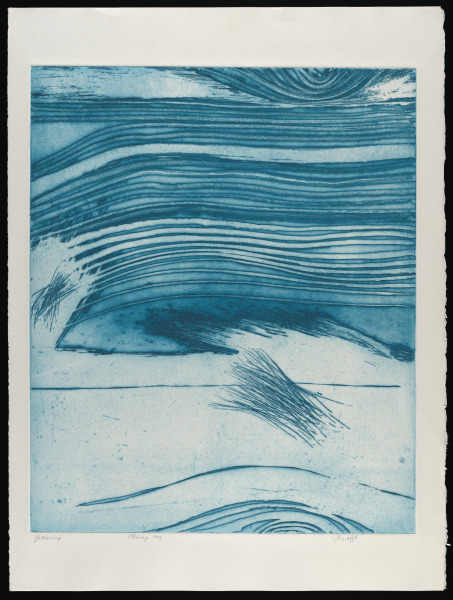 Gathering, 1973, Benjamin Wigfall (American, 1930-2017), etching on wove paper, 29 3/4 × 22 1/4 in. Virginia Musuem of Fine Arts, Arthur and Margaret Glasgow Endowment, 2022.195
Gathering, 1973, Benjamin Wigfall (American, 1930-2017), etching on wove paper, 29 3/4 × 22 1/4 in. Virginia Musuem of Fine Arts, Arthur and Margaret Glasgow Endowment, 2022.195 Wigfall left Hampton in 1963 after accepting a position in the art department at the State University of New York in New Paltz, specifically as a professor of printmaking. He did, not, however, leave his practice as a painter completely behind. From the later 1950s through the 1960s, Wigfall merged aspects of printmaking and painting in his assemblages.
A common element in all these works is an intense shade of blue paint, while most of them also show evidence of his woodburning technique, which was not unlike the etching process of engraving a metal plate.
Gathering provides an important link between Wigfall’s assemblage technique and his printmaking practice. Whereas he used wood and blue paint to build his assemblage compositions, here he incorporated a pattern suggesting woodgrain as part of the abstract image, layering it horizontally and printing it in blue.
Explore more of Wigfall’s assemblages below.
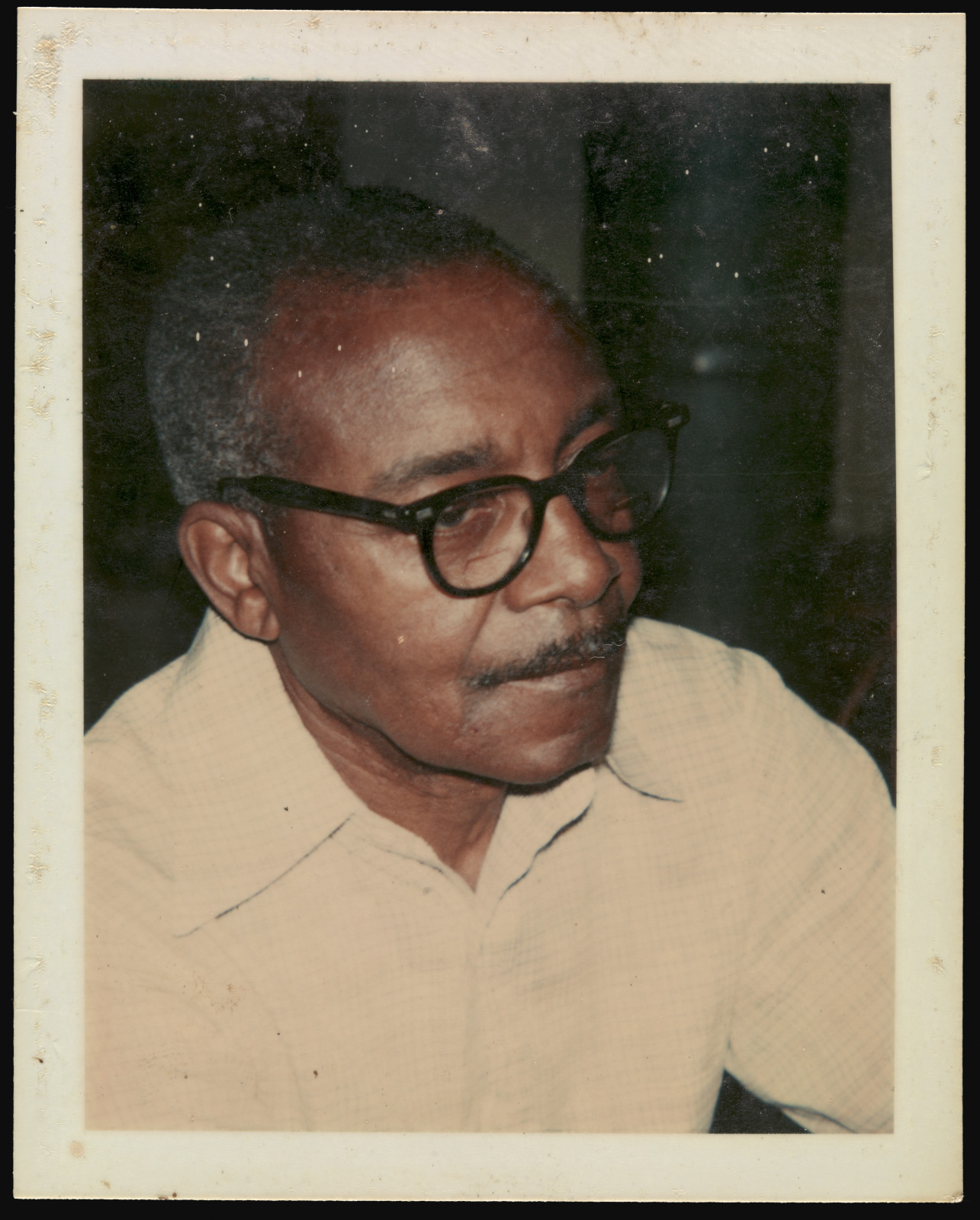 James Andrew Wigfall, ca. 1968, color photograph, 4 ¼ x 3 ¼ in. Benjamin L. Wigfall Artist Archives (VA-12). VMFA Archives, Richmond, Virginia, VA12.03.1.00
James Andrew Wigfall, ca. 1968, color photograph, 4 ¼ x 3 ¼ in. Benjamin L. Wigfall Artist Archives (VA-12). VMFA Archives, Richmond, Virginia, VA12.03.1.00 The playlist below features prints created by Wigfall with excerpts from an interview he conducted with his father, James Andrew Wigfall (featured at left). These excerpts come from a longer conversation Wigfall recorded in the late 1960s about their family’s roots. His father’s words, voice, and cadence inspired Wigfall to begin translating sound into dynamic visual compositions, leading to the development of what he described as “audio-graphic expression.”
“The sound tape and the print is each a work in its own right. When the tape is played while viewing the print, the feedback between the contemplative stimulation of both the audial and visual senses will create a new aesthetic experience and information different from each single format without loss of either.” – Benjamin Wigfall
Benjamin Wigfall, Untitled (He Was a Tall Man), 1975, intaglio on wove paper, 30 × 22 1/4 in. Virginia Museum of Fine Arts, Arthur and Margaret Glasgow Endowment, 2022.220
Benjamin Wigfall, Things My Father Told Me, Tall Man II, 1977, intaglio on wove paper, 27 9/16 × 39 1/4 in. Virginia Museum of Fine Arts, Arthur and Margaret Glasgow Endowment, 2022.210
Benjamin Wigfall, Ever Since, 1973, intaglio on Arches wove paper, 30 × 22 1/4 in. Virginia Museum of Fine Arts, Arthur and Margaret Glasgow Endowment, 2022.218
Benjamin Wigfall, Like Some of Us, Some Other of Us, 1969, intaglio on wove paper, 22 × 29 3/4 in. Virginia Museum of Fine Arts, Arthur and Margaret Glasgow Endowment, 2022.208
Benjamin Wigfall, Things My Father Told Me, 1973, etching on wove paper, 27 × 22 ¼ in. Virginia Museum of Fine Arts, Arthur and Margaret Glasgow Endowment, 2022.219
Communications Village Poster, ca. 1976–78, Communications Village, 14 x 17 ½ in. Benjamin L. Wigfall Artist Archives (VA-12), Gift of Michael Gino Wigfall and Gia Oke-Bello, Margaret R. and Robert M. Freeman Library, VMFA Archives, VA12.04.7.001
When he began at SUNY New Paltz, Wigfall was the only Black faculty member. In the context of this overwhelmingly white environment and the civil rights movement, he began to search for ways to root his practice in a Black community and thereby to incorporate Black voices and culture into his work. He eventually found an abandoned, brick livery stable in the Ponckhockie neighborhood of nearby Kingston, which he planned to renovate into his studio. As youth from the community began to help, his practice as a printmaker quickly merged with his philosophy as an arts educator.
Wigfall founded Communications Village in 1973, and it became a community gathering place as well as a printmaking and photography studio that offered art classes. He conceived of the effort as a merging of “traditional art” with participatory, collective, and aesthetic expression rooted in simple, daily lived experiences. Before long, he welcomed fellow artists from New York City, as well as colleagues and recent graduates from SUNY New Paltz, to make prints at the studio as they also engaged with the community.
Learn more about Communications Village by watching the video below.
Wigfall mounted the first exhibition of prints made by Communications Village’s visiting artists in December of 1976. Although they all etched their own plates, the Communications Village students pulled the prints, each in an edition of fifty.
In 1979, Communications Village produced a pamphlet, Intaglio Print Editions, picturing the prints and images from the exhibition. When fully open, every print of the series appears on the verso. Wigfall’s center essay offers the longest explanation of his vision for the visiting-artist program. He especially focused on Communication Village’s relationship to the surrounding neighborhood of Ponckhockie in Kingston, where many of the families had migrated from Virginia and the Carolinas, as had he and his family.
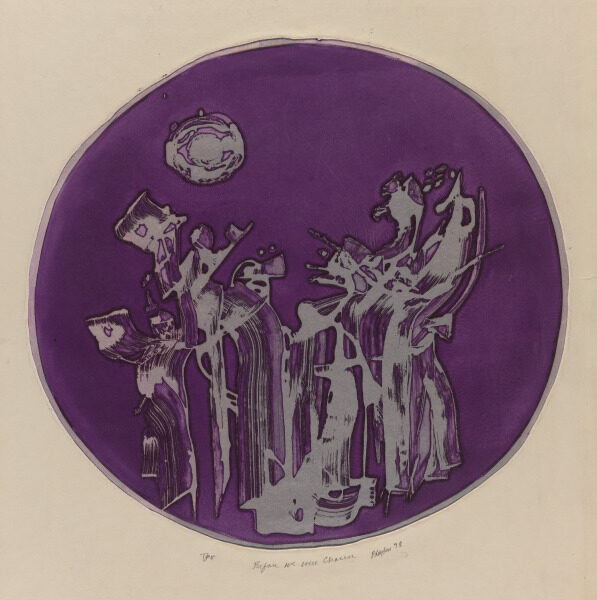 Night Dancers (Purple Edition), ca. 1972-1982, Betty Blayton (American, 1937-2016), violets, blue, orange/ Strathmore paper, 16 1/2 diameter x 16in. Courtesy of the Estate of Betty Blayton © Estate of Betty Blayton
Night Dancers (Purple Edition), ca. 1972-1982, Betty Blayton (American, 1937-2016), violets, blue, orange/ Strathmore paper, 16 1/2 diameter x 16in. Courtesy of the Estate of Betty Blayton © Estate of Betty Blayton Communications Village hosted many other leading artists as advisors or for artists talks. Included were Romare Bearden, Ernest Crichlow, Mavis Pusey, and Robert Hamilton Blackburn. When Mavis Pusey spoke at Communications Village, she presented a slide show that included Decaying Construction. Wigfall recorded her conversation with the community in which she described the inspiration for her series on gentrification. As she explained abstract art to the students, she also emphasized that her own compositions were always based in the ordinary things around her. Decaying Deconstruction can be read both as a dynamic abstract composition and an image of demolition and deconstruction. She went on to elaborate on the power of observation as the first step in making art and encouraged the youth to look around them.
Listen to an excerpt of Mavis Pusey’s visiting-artist talk at Communications Village.
ListenBenjamin Wigfalls Churchill: The 2017-18 Museum Leaders in Training [M.LiT] program focused on museum archival collections and documentation and resulted in a walking tour of the Churchill neighborhood. This project sought to document Benjamin Wigfall and his experiences as a young artist living in the hisotric neighborhood of Church Hill. Explore the project!
Learn more in the exhibition catalogue: Benjamin Wigfall & Communications Village Catalogue
Printmaking in Richmond: Want to learn more about the printmaking process or create your own print? To find classes and workshops in the Richmond-area please visit Studio Two Three, the Visual Arts Center of Richmond, VMFA Studio School, Oakwood Arts, ART 180 and Art on Wheels.